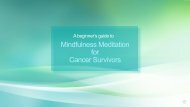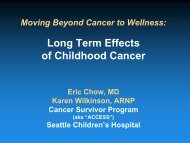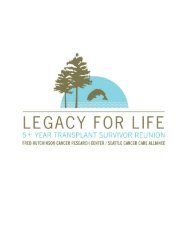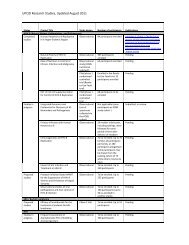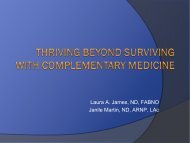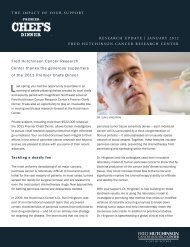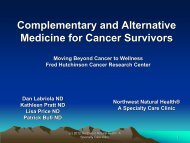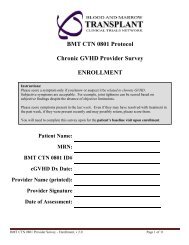Lexi Harlow, DPT, CLT Physical Therapy Department Seattle ...
Lexi Harlow, DPT, CLT Physical Therapy Department Seattle ...
Lexi Harlow, DPT, CLT Physical Therapy Department Seattle ...
Create successful ePaper yourself
Turn your PDF publications into a flip-book with our unique Google optimized e-Paper software.
<strong>Lexi</strong> <strong>Harlow</strong>, <strong>DPT</strong>, <strong>CLT</strong><br />
<strong>Physical</strong> <strong>Therapy</strong> <strong>Department</strong><br />
<strong>Seattle</strong> Cancer Care Alliance<br />
June 26 th , 2010
Presentation Topics<br />
1) What are the benefits of exercise?<br />
2) How can exercise help cancer survivors?<br />
3) What does research on survivors tell us about the<br />
importance of exercise?<br />
4) How much and what should I do for exercise?<br />
5) How can physical therapy help me?<br />
6) What exercise programs are available for cancer<br />
survivors?
General Benefits of Exercise<br />
PHYSICAL<br />
Cardiovascular fitness<br />
Building muscle<br />
strength<br />
Cancer and chronic<br />
disease prevention<br />
Weight loss<br />
Improve balance<br />
Osteoporosis<br />
prevention<br />
EMOTIONAL<br />
Decrease depression<br />
Energy boost<br />
Improve sleep quality<br />
lifestyleguide.us
How Can Exercise Help Cancer<br />
Survivors?<br />
The benefits of exercise and physical<br />
activity can help survivors to address some<br />
of the side effects of surgery, chemotherapy,<br />
and radiation.
Possible Side Effects of Surgery<br />
Scar tissue restrictions<br />
Limited range of motion or flexibility
Possible Side Effects of<br />
Chemotherapy<br />
Change of body image<br />
‐Hair loss<br />
‐Weight gain or loss<br />
Diarrhea or malnutrition<br />
Peripheral edema<br />
Fever, risk of infection<br />
Orthostatic hypotension<br />
Peripheral neuropathy<br />
Balance loss
Possible Side Effects of Radiation<br />
Fatigue<br />
Osteopenia<br />
Neutropenia<br />
Radiation induced<br />
fibrosis contracture<br />
Fragile skin or tissue
What Do Survivors Notice?<br />
“I can’t get my shoes on anymore.”<br />
(Edema or swelling in feet)<br />
“I can’t lift what I used to be able to.”<br />
(Decreased strength or muscle mass)<br />
“I catch myself stumbling or reaching for the<br />
wall.”<br />
(Decreased balance and safety)<br />
“I need someone to help me do chores around the<br />
house.”<br />
(Decreased independence)<br />
“I have to rest when going upstairs or on inclines.”<br />
(Decreased endurance)
Do Survivors Need Exercise?
Research: Survivors and Exercise<br />
“Survivors tend to<br />
decrease their physical<br />
activity levels after their<br />
diagnosis of cancer, and<br />
most continue lower levels<br />
of activity through<br />
treatment and beyond,<br />
rarely returning to their<br />
pre‐diagnosis levels of<br />
activity.”<br />
Irwin, Crumley, McTiernan, et al. 2003;<br />
Courneya & Friedenreich 1997<br />
www.examiner.com
Summary of Exercise Research<br />
What types of cancer<br />
have been studied?<br />
Prostate<br />
Breast<br />
Lung<br />
Colorectal<br />
Gynecologic<br />
Head/Neck<br />
Lymphoma<br />
Leukemia<br />
What has exercise<br />
improved in cancer<br />
survivors?<br />
Aerobic fitness<br />
Muscle strength<br />
Body composition<br />
Pain<br />
Depression<br />
Fatigue<br />
Quality of Life<br />
Chance of Recurrence<br />
Mortality
New Cancer Exercise Guidelines<br />
New recommendations made after expert panel reviewed<br />
and evaluated literature on the safety and outcomes of<br />
exercise training during and after cancer therapy.<br />
Cancer patients and survivors should get the same 150<br />
minutes per week of moderate‐intensity aerobic exercise<br />
that is recommended for the general public.<br />
Health care providers should tailor exercise<br />
recommendations to individual patients based on fitness<br />
level and side effects from treatment.<br />
University of Pennsylvania School of Medicine (2010, June 1). New cancer guidelines: Exercise<br />
during and after treatment is now encouraged. Science Daily.
World Cancer Research Fund:<br />
<strong>Physical</strong> Activity Recommendations for<br />
Survivors<br />
Be physically active as part of everyday life<br />
Be moderately physically active, equivalent to<br />
brisk walking, for at least 30 minutes every day<br />
As fitness improves, aim for 60 minutes or more<br />
of moderate, or for 30 minutes or more of<br />
vigorous, physical activity every day<br />
Limit sedentary habits such as watching television
General Exercise<br />
Recommendations<br />
US Dept of Health and Human Services:<br />
2008 <strong>Physical</strong> Activity Guidelines for Adult Americans<br />
2.5 hours/week of moderate intensity or 1.25<br />
hours/week of vigorous intensity<br />
Should increase to 5 hours/week of moderate<br />
intensity or 2.5 hours/week of vigorous intensity<br />
2x/week of strengthening of major muscle groups
General Exercise<br />
Recommendations<br />
Cardiovascular<br />
Daily if possible,<br />
minimum of 30 minutes<br />
Warm‐up/Cool‐down<br />
Target HR Zone
General Exercise<br />
Recommendations<br />
Strength training<br />
2‐3x/week<br />
For arms, abdominals,<br />
and legs<br />
Slow, steady<br />
progression
General Exercise<br />
Recommendations<br />
Stretching<br />
2‐3x/week<br />
Avoiding injury<br />
Importance of technique<br />
Yoga<br />
www.emzr.com
Exercise Precautions<br />
Always consult with your MD or other<br />
practitioner to clear you for exercise<br />
Seek advice from a trained professional (PT)<br />
Blood lab values (platelets, Hct, Hgb)<br />
Metastases<br />
Heart conditions<br />
Lymphedema<br />
Chronic orthopedic injuries
Other Considerations<br />
Gradually increase time and intensity<br />
Proper hydration and rest<br />
Cross training<br />
Use of appropriate equipment<br />
Dressing properly
HELP!<br />
Join a team<br />
(accountability)<br />
Get your spouse, best<br />
friend, children, or<br />
animals to join in<br />
Exercise journal or log<br />
Local classes or support<br />
groups<br />
Join a gym<br />
www.foreverfitwomen.com
PHYSICAL THERAPY!<br />
Survivors should get consultation as soon as possible<br />
after diagnosis<br />
Focus on education, especially exercise precautions<br />
and safety<br />
Manual therapy (stretching, scar tissue mobility, etc.)
PHYSICAL THERAPY!<br />
Exercise prescription and consultation for managing<br />
fatigue and improving endurance<br />
Comprehensive individually tailored exercise program<br />
prescription which includes cardiovascular<br />
conditioning, strength training, and flexibility<br />
exercises
<strong>Seattle</strong> Area Exercise Programs<br />
Cancer Lifeline<br />
(www.cancerlifeline.org)<br />
‐Stretch and Strengthen, Yoga, Lebed<br />
Team Survivor Northwest<br />
(www.teamsurvivornw.org)<br />
‐Women only; yoga, fitness training, swimming, hiking, dragon boating and<br />
canoeing, biking<br />
Gilda’s Club<br />
(www.gildasclubseattle.org)<br />
‐Yoga, Pilates, Tai Chi<br />
YMCA Exercise and Thrive<br />
(www.seattleymca.org)<br />
‐10 week fitness program; need medical clearance
Exercise and Thrive Program<br />
12‐week, 2x/week, 90 min. strength<br />
and fitness program for survivors<br />
Training provided by Y and the<br />
SCCA / Hutchinson Center<br />
Content foci: resistance exercise<br />
didactic/support<br />
13 locations, 26 sessions to date<br />
www.fhcrc.org/exerciseandthrive
EXERCISE!<br />
Exercise is something you have control over before,<br />
during, and after treatment…this doesn’t change.<br />
You may not have control over many factors during<br />
treatment…but you do have a say in helping yourself<br />
recover faster, making yourself feel better, and<br />
ensuring a great quality of life as a cancer survivor!
Acknowledgements and References<br />
“Clinical Implications for Therapists Working with<br />
Oncology Patients”, 11/06, Andrea Leiserowitz, MPT<br />
Rachel Douglas, MPT<br />
American Cancer Society<br />
Nutrition and <strong>Physical</strong> Activity During and After Cancer<br />
Treatment: An American Cancer Society Guide for Informed<br />
Choices; Doyle et. al; CA Cancer J Clin 2006;56;323‐353.<br />
World Cancer Research Fund/American Institute for Cancer<br />
Research. Food, Nutrition, <strong>Physical</strong> Activity, and the<br />
Prevention of Cancer: a Global Perspective. Washington,<br />
DC: AICR, 2007.<br />
US <strong>Department</strong> of Health and Human Services: 2008<br />
<strong>Physical</strong> Activity Guidelines for Americans
ANY QUESTIONS?



